
Palace of Fontainebleau, located 55 kilometers southeast of the center of Paris, in the commune of Fontainebleau, is one of the largest French royal châteaux. The medieval castle and subsequent palace served as a residence for the French monarchs from Louis VII to Napoleon III. Francis I and Napoleon were the monarchs who had the most influence on the palace as it stands today. It became a national museum in 1927 and was designated a UNESCO World Heritage Site in 1981 for its unique architecture and historical importance.

The School of Fontainbleau refers to two periods of artistic production in France during the late French Renaissance centered on the royal Palace of Fontainebleau that were crucial in forming Northern Mannerism, and represent the first major production of Italian Mannerist art in France.

Alessandro Bonvicino, more commonly known as Moretto, or in Italian Il Moretto da Brescia, was an Italian Renaissance painter from Brescia, where he also mostly worked. His dated works span the period from 1524 to 1554, but he was already described as a master in 1516. He was mainly a painter of altarpieces that tend towards sedateness, mostly for churches in and around Brescia, but also in Bergamo, Milan, Verona, and Asola; many remain in the churches they were painted for. Most are on canvas, but a number even of large ones are on wood panel. Only a handful of drawings survive.

Jacopo Caraglio, Giovanni Jacopo Caraglio or Gian Giacomo Caraglio known also as Jacobus Parmensis and Jacobus Veronensis was an Italian engraver, goldsmith and medallist, born at Verona or Parma. His career falls easily into two rather different halves: he worked in Rome from 1526 or earlier as an engraver in collaboration with leading artists, and then in Venice, before moving to spend the rest of his life as a court goldsmith in Poland, where he died.
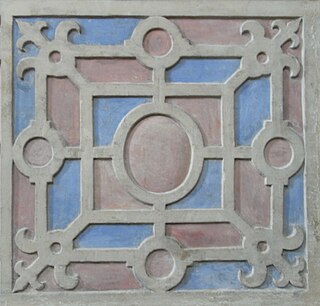
In the history of art and design, strapwork is the use of stylised representations in ornament of ribbon-like forms. These may loosely imitate leather straps, parchment or metal cut into elaborate shapes, with piercings, and often interwoven in a geometric pattern. In early examples there may or may not be three-dimensionality, either actual in curling relief ends of the elements, or just represented in two dimensions. As the style continued, these curling elements became more prominent, often turning into scrollwork, where the ends curl into spirals or scrolls. By the Baroque scrollwork was a common element in ornament, often partly submerged by other rich ornament.
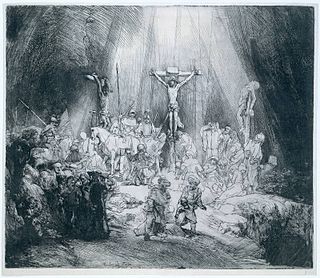
An old master print is a work of art produced by a printing process within the Western tradition. The term remains current in the art trade, and there is no easy alternative in English to distinguish the works of "fine art" produced in printmaking from the vast range of decorative, utilitarian and popular prints that grew rapidly alongside the artistic print from the 15th century onwards. Fifteenth-century prints are sufficiently rare that they are classed as old master prints even if they are of crude or merely workmanlike artistic quality. A date of about 1830 is usually taken as marking the end of the period whose prints are covered by this term.

Giorgio Ghisi was an Italian engraver from Mantua who also worked in Antwerp and in France. He made both prints and damascened metalwork, although only two surviving examples of the latter are known. He worked in a late Mannerist style.

French Renaissance architecture is a style which was prominent between the late 15th and early 17th centuries in the Kingdom of France. It succeeded French Gothic architecture. The style was originally imported from Italy after the Hundred Years' War by the French kings Charles VII, Louis XI, Charles VIII, Louis XII and François I. Several notable royal châteaux in this style were built in the Loire Valley, notably the Château de Montsoreau, the Château de Langeais, the Château d'Amboise, the Château de Blois, the Château de Gaillon and the Château de Chambord, as well as, closer to Paris, the Château de Fontainebleau.
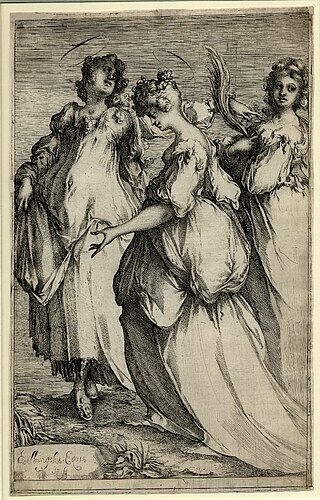
Jacques Bellange was an artist and printmaker from the Duchy of Lorraine whose etchings and some drawings are his only securely identified works today. They are among the most striking Northern Mannerist old master prints, mostly on Catholic religious subjects, and with a highly individual style. He worked for fourteen years in the capital, Nancy as court painter to two Dukes of Lorraine, before dying at the age of about forty, and almost all his prints were produced in the three or four years before his death. None of his paintings are known to have survived, but the prints have been known to collectors since shortly after his death, though they were out of critical favour for most of this period. In the 20th century they have been much more highly regarded, although Bellange is still not a well-known figure.
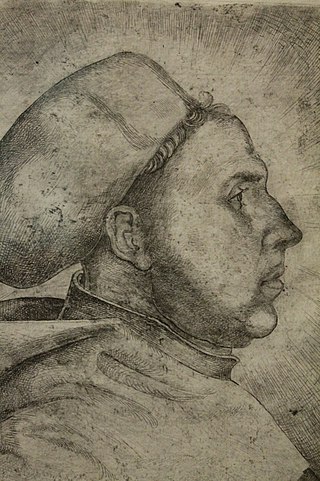
Daniel Hopfer was a German artist who is widely believed to have been the first to use etching in printmaking, at the end of the fifteenth century. He also worked in woodcut. Although his etchings were widely ignored by art historians for years, more recent scholarship is crediting him and his work with "single-handedly establishing the salability of etchings" and introducing the print publisher business model.

Giovanni Antonio da Brescia was an Italian engraver of northern Italy, active in the approximate period 1490–1519, during the Italian Renaissance. In his early career he used the initials "Z.A." to sign some twenty engravings, and until recently Zoan Andrea was regarded as a distinct printmaker; it is now realized that they are the same person, and the "Z.A." stood for Giovanni Antonio, "Zovanni" being a north Italian spelling. Around 1507 he began to use formulae such as "IO.AN.BX.", and signed some prints more fully. The real Zoan Andrea was a very obscure painter, documented as working in Mantua in the 1470s, who produced no engravings.

The artists of the Tudor court are the painters and limners engaged by the monarchs of England's Tudor dynasty and their courtiers between 1485 and 1603, from the reign of Henry VII to the death of Elizabeth I.
Anthony Toto or "Antony", real name Antonio di Nunziato d'Antonio (1498–1554), was an Italian painter and architect at the English court.

Luca Penni (c.1500/1504–1556) was an Italian painter of the 16th century best known for his work in France as part of the First School of Fontainebleau. He was nicknamed Le Romain.

Juste de Juste was a Franco-Italian sculptor and printmaker in etching, a member of the Betti family of sculptors from near Florence, who became known as the Juste family in France, where Juste de Juste's father Antonio and his two brothers emigrated and spent most of their careers. Juste de Juste has been widely accepted as the author of seventeen etchings of naked or écorché (flayed) male figures signed with a complicated monogram. He also worked as a stuccoist of the School of Fontainebleau under Rosso Fiorentino.

Northern Mannerism is the form of Mannerism found in the visual arts north of the Alps in the 16th and early 17th centuries. Styles largely derived from Italian Mannerism were found in the Netherlands and elsewhere from around the mid-century, especially Mannerist ornament in architecture; this article concentrates on those times and places where Northern Mannerism generated its most original and distinctive work.
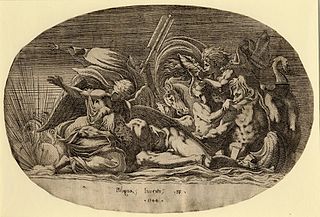
Antonio Fantuzzi was an Italian painter and printmaker active in the French Renaissance in a Mannerist style. All that is known about his early life is that he was born in Bologna, from the accounts at Fontainebleau and one inscription on a print.
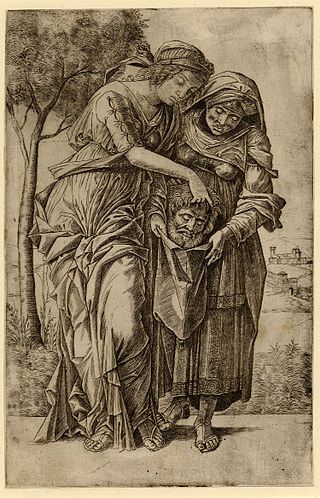
Girolamo Mocetto was an Italian Renaissance painter, engraver, and stained glass designer. He was heavily influenced by Domenico Morone, Giovanni Bellini, Bartolomeo Montagna, Cima da Conegliano, and especially Andrea Mantegna. He is most important as an engraver, and his engravings of the compositions of others are his most successful prints.

Léon Davent was a French printmaker in the mid 16th century, closely associated with the First School of Fontainebleau. He worked in both engraving and etching and many of his works are based on designs by Francesco Primaticcio, "rendered boldly and freely". Others use designs by Luca Penni and other artists. It is thought that there was a workshop at the Palace of Fontainebleau itself in the 1540s, where he was one of the leading printmakers. Their main purpose seems to have been to record the new style being forged at Fontainebleau, copying both the main subject paintings and the elaborate ornamental stuccos and other decorations.

Master MZ was an engraver active in south Germany around 1500. He signed his 22 engravings with his monogram "MZ", and six are dated, all 1500, 1501 or 1503. He worked in Munich in Bavaria, and in 1500 seems to have been connected to the court of Albert IV, Duke of Bavaria. There are complicated but inconclusive arguments for and against identifying him with a goldsmith called Matthäus Zaisinger, a painter known as Master MS, and other figures.


























